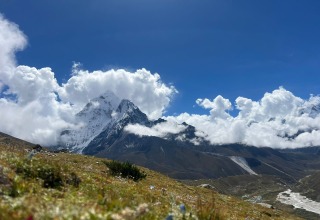Dreaming of standing beneath the towering peaks of Mount Everest but worried your wallet can’t make the climb? You’re not alone. The Everest Base Camp trek is a bucket-list adventure, but many travelers assume it’s only for those with deep pockets.
The truth is, you don’t need a luxury budget to experience the majesty of the Himalayas. With smart planning and a few insider tips, budget travelers can complete the Everest Base Camp trek without sacrificing comfort or safety. From affordable accommodations to low-cost meals and gear hacks, there are countless ways to cut expenses without cutting corners.
This guide breaks down how to trek to Everest Base Camp on a budget—without freezing in a flimsy sleeping bag or surviving on instant noodles. Whether you’re a student traveler, a backpacking enthusiast, or simply someone seeking adventure on a budget, we’ll show you how to make every rupee count.
By the end, you’ll know exactly where to save, where to spend, and how to get the most out of your trek—comfortably and affordably.
Why Budget Travelers Should Consider the Everest Base Camp Trek
The Everest Base Camp (EBC) trek is one of the world’s most iconic adventures, and it’s more accessible than many believe. While it’s often associated with high costs and luxury expeditions, the truth is that budget travelers can experience the magic of EBC without spending a fortune.
Many assume that trekking to Everest Base Camp requires expensive gear, high-end guides, or luxury lodges. However, thousands of independent and budget-conscious trekkers complete the journey each year with minimal expenses. The key lies in smart planning and understanding where to save without cutting corners on safety or comfort.
For budget travelers, the EBC trek offers unbeatable value. You’ll get panoramic Himalayan views, cultural immersion in Sherpa villages, and the satisfaction of reaching 5,364 meters—all without needing to splurge. The trail is well-established, with ample budget accommodations and food options, making it ideal for cost-conscious adventurers.
Moreover, the Everest region has a strong infrastructure for trekkers. From affordable teahouses to community-based services, the region supports low-cost travel without sacrificing essentials. With a little flexibility and preparation, even travelers on tight budgets can enjoy a rich, fulfilling trekking experience.
If you’re dreaming of the Himalayas but worried about cost, the Everest Base Camp trek is entirely feasible. By choosing the right season, going with a group, or trekking independently, you can tailor your journey to your financial comfort zone.
How Much Does the Everest Base Camp Trek Cost on a Budget?
For budget travelers, understanding the typical expenses of the Everest Base Camp trek is essential. While prices vary depending on the season and choices, a well-planned budget trek can cost anywhere from $1,000 to $1,500 USD for the entire journey, excluding international airfare.
Rough Cost Breakdown
- Flights (Kathmandu to Lukla round-trip): $180–$400
- Permits (Sagarmatha National Park + Khumbu Pasang Lhamu Rural Municipality Entry Permit): ~$50
- Accommodation (teahouses): $3–$10 per night
- Meals: $20–$30 per day
- Guide/Porter (optional): $20–$30/day for a guide, $15–$25/day for a porter
- Miscellaneous (Wi-Fi, charging, snacks): $50–$100 total
Compared to luxury treks that can cost $2,000–$4,000 or more, the budget version offers incredible savings. The trade-off is fewer frills—no private bathrooms, gourmet meals, or helicopters—but the core experience remains the same.
Daily expenses for budget trekkers typically range between $25 and $40. This includes three meals, a basic teahouse room, and occasional extras like hot showers or charging fees. If you hire a guide or porter, costs will increase, but group treks can offset this.
With careful spending and smart choices, the Everest Base Camp trek is entirely doable on a modest budget.
Best Time to Trek Everest Base Camp on a Budget
Timing your trek strategically can significantly impact your budget. The cheapest time to trek to Everest Base Camp is during the off-seasons—late November to early March and June to early September. These periods see fewer tourists, so prices for flights and accommodations are often lower.
Seasonal Cost Considerations
- Peak seasons (March–May, October–early November): Higher prices due to demand. Expect crowded trails and full teahouses.
- Off-season (winter and monsoon): Lower costs, but weather challenges like snow or rain can affect comfort and safety.
Winter treks (December–February) offer crystal-clear skies and quiet trails, but you’ll need proper gear for freezing temperatures. Monsoon season (June–September) brings lush greenery but also rain and potential flight delays.
If you’re on a tight budget and willing to endure colder nights or some rain, off-season trekking can save you hundreds. Flights to Lukla are cheaper, and teahouses may offer discounts or free rooms in exchange for eating meals there.
Additionally, booking flights and accommodations in advance during shoulder seasons (late February or late November) can help you snag deals while still enjoying decent weather.
Budget-Friendly Trekking Options: Independent vs. Guided
One of the biggest decisions for budget travelers is whether to trek independently or hire a guide. Both options have pros and cons, and your choice will impact your overall cost.
Independent Trekking
Trekking independently is the most budget-friendly option. You’ll save on guide and porter fees and have full control over your pace and itinerary. The trail to Everest Base Camp is well-marked, and villages are spaced closely, making navigation manageable for experienced trekkers.
However, going solo isn’t for everyone. Language barriers, altitude sickness, and emergencies can be challenging without support. It’s essential to have good trekking experience and basic knowledge of altitude illness prevention.
Guided or Group Trekking
Affordable options include:
- Hiring a freelance guide in Kathmandu: $20–$30/day
- Sharing a guide among 2–4 trekkers to split costs
- Hiring a porter only: $15–$25/day
- Joining a group trek: $500–$900 total cost, often inclusive of permits, guide, and logistics
Group treks organized by local agencies are a great middle ground. They offer cost-sharing, safety, and logistics support while keeping prices low. Private treks are more flexible but costlier.
Safety Note: If trekking independently, ensure you have adequate insurance, knowledge of AMS (Acute Mountain Sickness), and a reliable emergency plan.
How to Save on Flights and Transportation to Everest Base Camp
Getting to Everest Base Camp starts with reaching Lukla, often via a short flight from Kathmandu. These flights can be expensive, especially during peak season. However, budget travelers have several strategies to reduce transportation costs.
Tips for Saving on Flights
- Book early: Lukla flights fill quickly. Booking 1–2 months in advance can secure lower fares.
- Fly from Ramechhap (Manthali): During busy seasons, flights to Lukla depart from Ramechhap, a 4–5 hour drive from Kathmandu. Though inconvenient, prices are often lower.
- Compare airlines: Tara Air, Summit Air, and Sita Air offer varying rates. Use local travel agents to find the best deal.
Alternative Routes to Avoid Flying
- Jiri to Lukla trek: Adds 5–7 days but eliminates flight costs. Great for acclimatization and budget savings.
- Salleri to Lukla trek: A 2–3 day walk after a jeep ride from Kathmandu. Cheaper and less crowded than Jiri.
While flying is faster, trekking in from Jiri or Salleri can save $150–$300 and enrich your experience with more cultural exposure. Just factor in the additional days and food/accommodation costs.
Affordable Accommodation on the Everest Base Camp Trek
Teahouses are the go-to lodging option for budget trekkers. These locally run guesthouses are found in every village along the EBC route and cater to all budgets.
Typical Teahouse Costs
- Lower elevations (Lukla to Namche): $5–$10/night
- Higher elevations (above Dingboche): Often free with meal purchase
- Peak season: Slightly higher prices or limited availability
Tips to Save Money on Accommodation
- Negotiate room rates: Especially in off-season, many teahouses offer free rooms if you eat dinner and breakfast there.
- Avoid pre-booking: Walk-in rates are often cheaper, and availability is rarely an issue outside peak months.
- Share rooms: Some teahouses offer dorm-style rooms or discounts for multiple guests.
While basic, teahouses are comfortable. Expect twin beds with blankets, shared bathrooms, and a communal dining area. Higher up, amenities become scarcer, but the warmth and hospitality remain.
Eating Well on a Budget During the Trek
Food prices increase with altitude, but you can still eat well on a budget.
Typical Meal Costs
- Lower elevations: $3–$5 per dish
- Higher elevations: $6–$10 per dish
Budget Food Tips
- Stick to local dishes: Dal Bhat (lentils, rice, and vegetables) is unlimited and filling.
- Avoid meat: It’s expensive and often carried up without refrigeration.
- Share dishes or order set menus: Many teahouses offer combo meals at better value.
- Bring snacks from Kathmandu: Trail mix, instant noodles, and energy bars are much cheaper in the city.
Hydration is key, but bottled water is costly—up to $3 per liter at high altitudes. Carry water purification tablets or a SteriPEN to treat tap or stream water safely.
Important: Always ensure drinking water is treated or boiled to avoid waterborne illnesses.
Essential Gear for Budget Travelers (Without Overpaying)
You don’t need to break the bank on trekking gear. Kathmandu’s Thamel area is packed with rental shops and budget gear outlets offering everything from down jackets to sleeping bags.
Renting Gear
- Down jacket: ~$1–$2/day
- Sleeping bag: ~$1/day
- Trekking poles: ~$1/day
Buying Gear
- Look for local brands like Kalapatthar or Sonam Gear—reasonably priced and well-reviewed.
- Explore second-hand gear shops for discounted items.
- Check for seasonal sales or package deals in Thamel.
Must-Have Items
- Waterproof hiking boots
- Thermal base layers
- Windproof jacket
- Warm hat and gloves
- Water purification method
Skip the extras like high-end GPS watches or branded outerwear unless you already own them. Focus on layering, staying dry, and keeping warm.
Pro Tip: Always test rented gear before the trek to ensure it fits and functions properly.
Final Tips for a Comfortable and Affordable Everest Base Camp Trek
Trekking to Everest Base Camp doesn’t have to break the bank. With smart planning—like choosing teahouses over luxury lodges, traveling in the shoulder seasons, and packing efficiently—you can experience the Himalayas without sacrificing comfort. Budget travel here is not only possible, it’s incredibly rewarding.
The key is balancing cost with experience. Prioritize what matters most to you—whether that’s a hot shower or a warm meal—and skip the extras you won’t miss. You’ll be surprised how far your money can go with the right mindset.
So lace up your boots, do your homework, and get ready for the adventure of a lifetime. The Everest Base Camp trek is calling—and now, you know how to answer it without overspending.






















